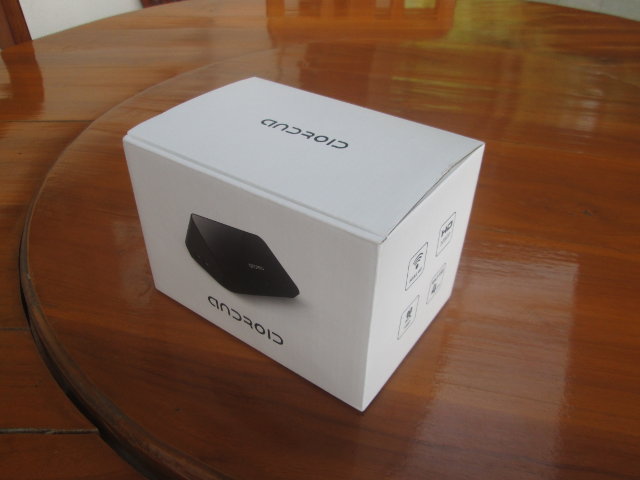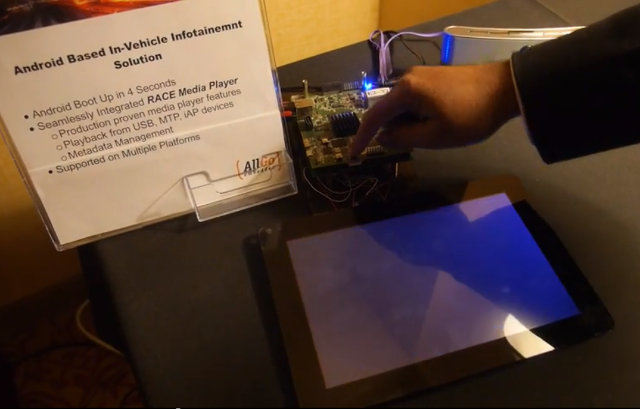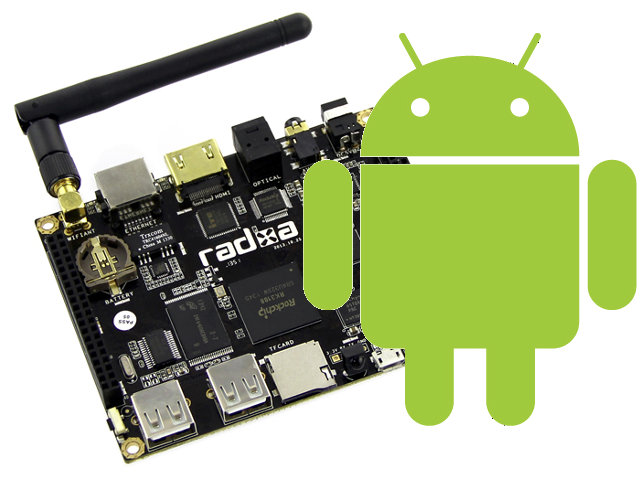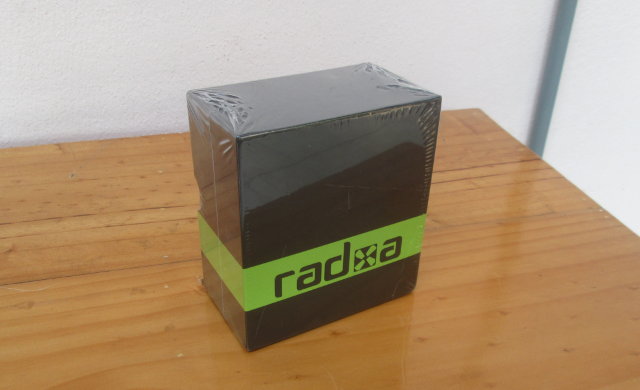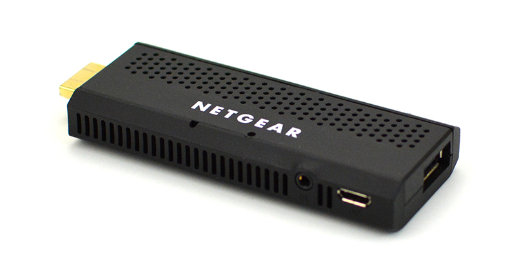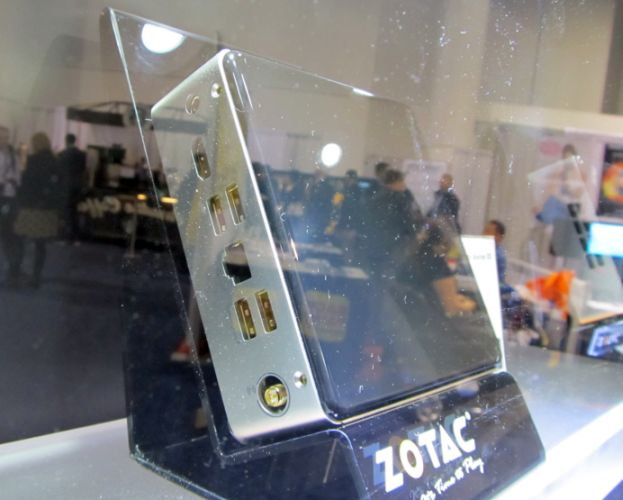Beelink A9 is an Android TV Box powered by Rockchip RK3188 SoC with 2GB RAM, and 8GB RAM (See full specs). The hardware is pretty standard, but the company released Android 4.4 SDK for the device, so when Beelink / Nexteon told me they wanted to send me one for review, I accepted. I won’t test the Android SDK today, but I’ll just show the pictures of the device, and run my usual series of tests for review. The shipped sample is not running Android 4.4 (beta), but Android 4.2.2. Unboxing Pictures I’ve received this Android media player in the no brand package below. I’m not sure if Beelink will sell directly to individuals, so you’ll likely to received some different if you order Tronsmart A928 or Zero Devices Z6C which are based on the same platform. There are quite a few accessories in the package: The box itself, a […]
AllGo Embedded Systems Android IVI System Boots in 4 Seconds
We’ve already seen several sub-second boot times for embedded Linux systems with platforms such as Beagleboard (TI OMAP 3530) and an AllWinner A10 based device, but I had never seen fast boot optimization for Android before, or I just forgot… Typically Android boots within 20 to 40 seconds on most devices, but AllGo Embedded Systems has optimized Android Jelly Bean boot time for their IVI (In-Vehicle Infotainment) platform running a media player called RACE. Charbax interviewed then at CES 2014, where they demoed the 4 seconds (actually 4.2 seconds) boot on Texas Instruments OMAP5 from reset and power, as you can see in the video below. (The video starts at 2:20 to show the demo directly). Beside Texas Instrument OMAP5, the solution is also available for Freescale i.MX6. 0xlab did some boot time optimizations for Android dropping the boot time from 30 seconds to 15 seconds. AllGo Embedded Systems did […]
Getting Started with Raxda Rock – Building an Android 4.2 Image from Source
I’ve posted some pictures, and show some basics how to get started in my first post about Radxa Rock. Today, I’ll post my experience trying the instructions to build Android for Radxa Rock in Ubuntu 13.10. Many of the instructions are also valid for other RK3188 devices. The source code is currently located in a private git repository, and if you’re sure you want to get the Android source code, you should send an e-mail to [email protected] to be granted access to their private repo. Within minutes, I’ve received an email with the subject “GitLab | Account was created for you” to register an account. You’ll then need to add an SSH key just like you’d do for Github. Assuming you’re already using a service like github, you should already have SSH key. Simply type cat ~/.ssh/id_rsa.pub, copy the output, and go to git.linux-rockchip.org/profile/keys, login if needed, and click on […]
Radxa Rock and ODROID-U3 Quad Core Development Boards Comparison
If you want a quad core development board for less than $100, you only have two choices right now: Radxa Rock powered by Rockchip RK3188, and Hardkernel ODROID-U3 powered by Samsung Exynos 4412 prime. There are also a few Freescale i.MX 6Q boards such as Wandboard Quad and UDOO Quad for around $130 which you could consider because of potentially better software support and features like SATA, but in this post, I’ll compare Radxa Rock and ODROID-U3 to help you decide which one may be right for your application or project. Let’s get right to the subject, with a side-by-side comparison table. Radxa Rock Hardkernel ODROID-U3 Comments Processor Rockchip RK3188 ARM Cortex-A9 quad core @ 1.6Ghz Samsung Exynos 4412 Prime quad core Cortex A9 @ 1.7 Ghz Slight advantage for ODROID-U3, but it’s basically a draw. GPU ARM Mali-400 MP4 GPU ARM Mali-400MP4 GPU @ 440MHz Same GPU, that’s a […]
Raxda Rock Development Board Unboxing, Quick Start Guide, and Benchmarks
Radxa Rock is an Android & Linux development board based on Rockchip RK3188 with 2GB RAM, 8GB NAND Flash, several I/Os that’s been available in beta version to a small number of developers in September 2013, with general availability starting at the very end of December 2013. Radxa team has sent me a board for me to try out. I’ll start with some unboxing pictures, write a Quick Start Guide for the first boot with Android 4.2.2, and run some benchmarks on the board. In another post, I’ll try some of the instructions to build Android and Ubuntu for the platform. Radxa Rock Unboxing Pictures & Video I’ve received the board in the following package via Fedex. Beside the board, we’ve got a Wi-Fi antenna, a USB power cable, and a plastic casing. Checkout Radxa Rock unboxing video below, if you want to find out exactly what’s you get when […]
NETGEAR NeoMediacast Android HDMI Dongle (NTV300D) Features Wi-Fi 802.11ac Module
NETGEAR has announced a new HDMI dongle called NeoMediacast, but also known as NTV300D model, running Android 4.2.2, with functionalities very similar to all the HDMI TV sticks / mini PCs originating from Chinese manufacturers we’ve seen for nearly 2 years. AFAIK, NETGEAR is the first relatively well-known global company to unveil an Android HDMI TV stick for the consumer market. [Update: see comments for details how it will reach the comsumer]Key features published for NTV300D by the company: Android 4.2+ supported with RDK support in the future 1080p/60 full HD, H.264/MPEG4 video decode Supports HDMI 1.4 and HDCP 2.1 Miracast-enabled Wi-Fi 802.11ac 1×1 AC 450 Mbps, Bluetooth 4.0 USB powered Micro SD slot for playback/storage Micro USB (OTG) for secondary storage Misc – Infrared Port, status LED DRM support for Microsoft PlayReady, Google Widevine and Adobe RTMPe Remote control unit – RF4CE or Bluetooth supported So there’s now information […]
Nvidia Tegra K1 Reference Tablet and Graphics Demo
With Tegra K1 and its Kepler GPU, Nvidia brings OpenGL 4.4, and not only OpenGL ES, to mobile devices, and the company is demo’ing OpenGL games such as Trine 2 on Tegra 4 reference tablet at CES 2014. Nvidia Tegra K1 Specifications In my initial post about Tegra K1 announcement, I missed some key features about Nvidia new processor which has now popped up on their website such as support for up to 8GB RAM, 4+1 configuration, etc and so listing a summary of the technical specifications of the 32-bit version may be useful: GPU – 192 NVIDIA CUDA cores using Kepler architecture CPU – NVIDIA 4-Plus-1 Quad-Core ARM Cortex-A15 “r3” up to 2.3 GHz Memory – DDR3L and LPDDR3, up to 8 GB with 40-bit address extension Display – LCD: Up to 3840×2160, HDMI: Up to 4K (UltraHD, 4096×2160) Package – 23×23 FCBGA, 16×16 S-FCCSP, or 15×15 FC PoP […]
ZOTAC to Sell ZBOX Nano mini PC based on Freescale i.MX6 SoC
ZOTAC, a company known to provide small x86 Linux PCs, is currently showcasing an ARM based version at CES 2014, part of their ZBOX nano series, running either Ubuntu 12.04 or Android 4.2 on a Freescale i.MX 6Quad processor. ZOTAC ZBox nano “ARM” specifications: SoC – Freescale i.MX 6Q quad core Cortex A9 @ 1 Ghz with Vivante GC2000 GPU System Memory – 1GB DDR3 Storage – 8GB eMMC flash, SATA 3Gb/s interface with 2.5″ HDD support, and SD card slot (SD/SDHC/MMC) Video Output – HDMI 1.4 USB – 4x USB 2.0 host port Connectivity – GbE Ethernet, and Wi-Fi 802.11 b/g/n via mini PCIe module. The computer currently runs Android 4.0.4 and Ubuntu 12.04 LTS, but Android 4.0.4 will be upgraded to Android 4.2. ZBOX nano “ARM” mini PC will be available in Q2 2014 for a price between $100 and $150. Via Liliputing Jean-Luc Aufranc (CNXSoft)Jean-Luc started CNX […]

